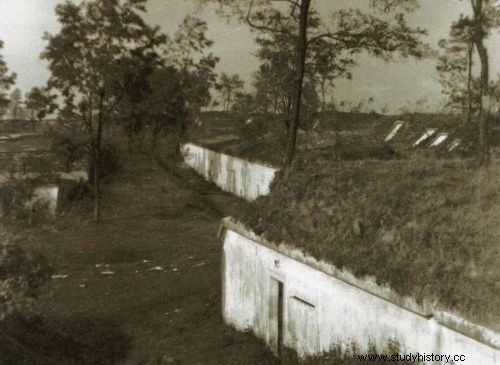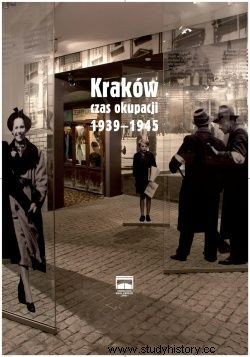It has become common ground in the public consciousness that Krakow managed to avoid the worst swastika terror during World War II (excluding the extermination of the Jewish population, of course). Meanwhile, the German occupier carried out mass murders not only in places such as Palmiry or Wawer. There are also points in Krakow and its vicinity where hundreds or even thousands of Poles died.
The site of the greatest crimes was the so-called Glinik in Przegorzały, whose name comes from the old clay excavation used for the production of bricks. The first mass execution took place there on November 11, 1939, and its victims were prisoners imprisoned in Montelupich. For the next five years (until 1944), the Germans - during 26 executions - killed nearly two thousand people in this place. .
Among the murdered were, among others, members of the independence underground and representatives of the Polish intelligentsia, murdered as part of Operation AB (German Ausserordentliche Befriedungsaktion ).

One of the mass graves of the execution victims in the Krzesławice fort (photo from the 1946 exhumation) (all photos are from the album "Krakow - time of occupation 1939-1945")
It is also worth mentioning that the Nazi torturers were so perfidious that forced the local population to bury the murdered .
The next point at which the Nazis massively shot the inhabitants of Kraków and the inhabitants of the Kraków district was the "Krzesławice" fort. As in Przegorzały, most of those inmates in prisons in Montelupich and St. Michael. Fifteen people, including three women, fell victim to the first execution on November 14, 1939. Over the next year and a half, the Germans killed about 440 people in the post-Austrian fortifications. .
As Monika Bednarek writes in one of the texts included in the album of the Historical Museum of the City of Krakow, entitled "Krakow - Nazi Occupation 1939-45":
The victims of the executions were people of different status and age, workers, inhabitants of villages near Krakow, people caught crossing the border illegally, reserve officers, intellectuals. In June 1940, 30 hostages from Myślenice, arrested for an attack on a post office in that city, were shot in the fort. The prisoners were forced to dig their own graves the day before their execution .
Among the unfortunates sentenced to death, who had to dig their own grave in the "Krzesławice" fort, was also Stanisław Marusarz. Excellent pre-war skier, world runner-up in ski jumping from Lahti (1938), caught in March 1940 in Slovakia during a courier mission for the Union of Armed Struggle.

The first victims of the mass execution in Przegorzały were prisoners in Montelupich. During the entire period of the war, nearly two thousand people lost their lives in the old clay excavation. The photo shows the Montelupich prison in the interwar period.
However, he was one of the few who managed - literally at the last moment - to escape from the prison in Montelupich, thanks to which he had the opportunity to recall that event many years later:
There are three targets left for the inmates. There were 134 of us, including four women . [...] We were in my third cell of 46 people, of various ages. The oldest was 71 years old, from Krakow, a bank manager, and the youngest […] was a 14-year-old boy from Biała Góra. A boy sentenced to death only for showing Poles that there is a way to the border here.
We were told to select holes:4 meters long, 2 meters deep and 2 meters wide . I knew these were our graves. In the morning, at four o'clock, three cars and the Gestapo arrived and took the first cell. Prisoners were loaded, including four women. They loaded the lime and shovels. They drove away. At 11 o'clock they returned. They brought clothes shot and covered with blood.

The buildings of the post-Austrian fort in Krzesławice, where in 1939-1941 the Germans shot about 440 people (all photos come from the album "Krakow - time of occupation 1939-1945")
The next place where the mass extermination of the Polish population of the Krakow district was carried out was on the outskirts of the Niepołomice Forest. It is difficult to find the exact number of murdered people, but undoubtedly over 1,500 people were killed there. . Apart from Poles, there were also Jews, French prisoners of war, and even Italian rebellious soldiers.

It was there that, on December 11, 1941, Dr. Stanisław Klimecki ended his life - in the years 1931-1939, the deputy mayor of Kraków, and from September 1939, the mayor of the city. As in the case of the "Krzesławice" fort, the victims had to dig their grave with their own hands, and the German policemen who carried out the execution killed them with a shot to the back of the head .
The list of places of execution of Polish inhabitants of Krakow also includes the area of the camp in Płaszów, which is associated rather with the ordeal of the Jewish population. However, also there, Poles, previously imprisoned in Montelupich and at St. Michael.
The above-mentioned examples of German terror against the inhabitants of Krakow are, of course, only one of the elements of the murderous whole, which consisted of street round-ups, public executions or shipments to concentration camps. One thing is beyond doubt - the reality of the war in Krakow was not as simple as some might think.
Sources:
Basic:
- Monika Bednarek, Edyta Gawron, Grzegorz Jeżowski, Barbara Zbroja, Katarzyna Zimmerer, Krakow under occupation 1939-1945 , Historical Museum of the City of Kraków, 2010.
Complementary:
- Andrzej Chwalba, Occupational Krakow in 1939-1945 , Wydawnictwo Literackie, 2011
- Andrzej Jeżowski, Pomorska Street - a guide , Historical Museum of the City of Kraków, 2011.
- Following the memory trail of 1939-45 in Niepołomice and its vicinity .
